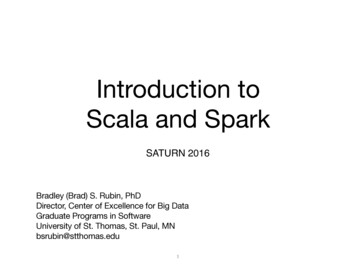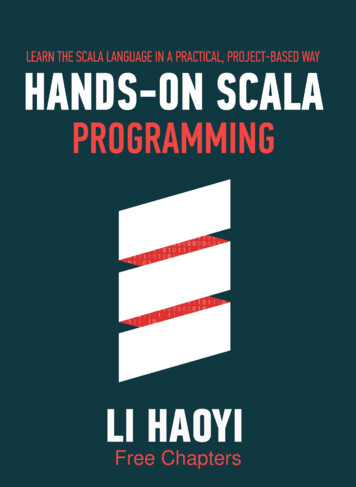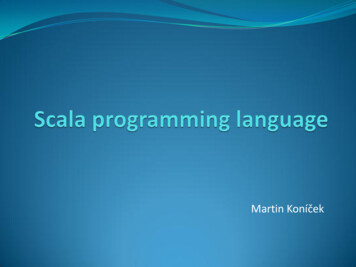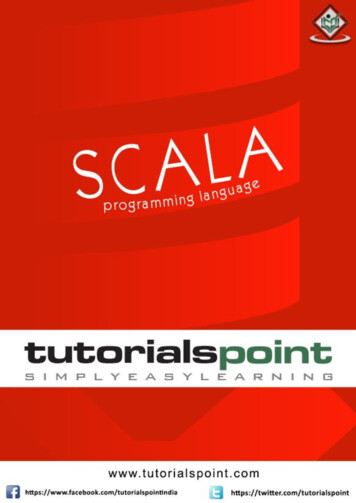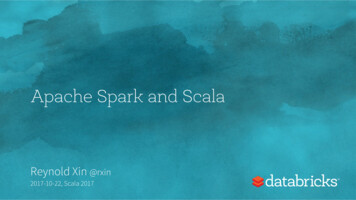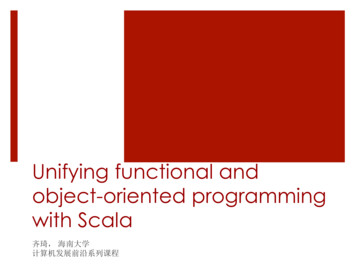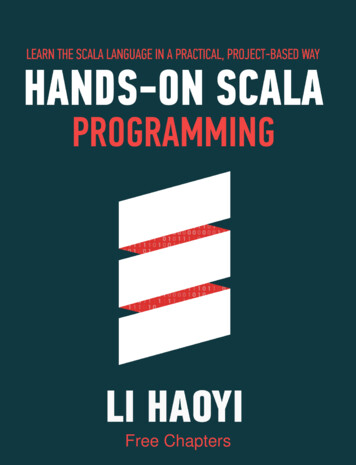
Transcription
Free Chapters
Hands-on Scala Programming Copyright (c) 2020 Li Haoyi (haoyi.sg@gmail.com)First Edition, published June 1 2020No part of this publication may be reproduced, stored in a retrieval system, or transmitted,in any form or by means electronic, mechanical, photocopying, or otherwise, without priorwritten permission of the Author.ISBN 978-981-14-5693-0Written and Published by Li HaoyiBook Website: https://www.handsonscala.com/Chapter Discussion: https://www.handsonscala.com/discussLive Chat: https://www.handsonscala.com/chatOnline materials: https://github.com/handsonscala/handsonscalaFor inquiries on distribution, translations, or bulk sales, please contact the author directly athaoyi.sg@gmail.com.The information in this book is distributed on an “As Is” basis, without warranty. While everyprecaution has been taken in the preparation of this work, the Author shall not have anyliability to any person or entity with respect to any loss or damage caused or alleged to becaused directly or indirectly by the information contained in it.ReviewersThanks to all the reviewers who helped review portions of this book and provide thefeedback that helped refine this book and make it what it is today.In alphabetical order:Alex Allain, Alwyn Tan, Bryan Jadot, Chan Ying Hao, Choo Yang, Dean Wampler, DimitarSimeonov, Eric Marion, Grace Tang, Guido Van Rossum, Jez Ng, Karan Malik, Liang Yuan Ruo,Mao Ting, Martin MacKerel, Martin Odersky, Michael Wu, Olafur Pall Geirsson, Ong MingYang, Pathikrit Bhowmick
Table of ContentsForeword9I Introduction to Scala131 Hands-on Scala152 Setting Up253 Basic Scala394 Scala Collections595 Notable Scala Features81II Local Development1056 Implementing Algorithms in Scala(not in sample) 1077 Files and Subprocesses(not in sample) 1098 JSON and Binary Data Serialization(not in sample) 1119 Self-Contained Scala Scripts(not in sample) 11310 Static Build Pipelines(not in sample) 115III Web Services11711 Scraping Websites(not in sample) 11912 Working with HTTP APIs(not in sample) 12113 Fork-Join Parallelism with Futures(not in sample) 12314 Simple Web and API Servers(not in sample) 12515 Querying SQL Databases(not in sample) 127IV Program Design12916 Message-based Parallelism with Actors(not in sample) 13117 Multi-Process Applications(not in sample) 13318 Building a Real-time File Synchronizer(not in sample) 13519 Parsing Structured Text(not in sample) 13720 Implementing a Programming Language(not in sample) 139Conclusion141
Part I Introduction to Scala1 Hands-on Scala151.1 Why Scala?161.2 Why This Book?171.3 How This Book Is Organized181.4 Code Snippet and Examples201.5 Online Materials222 Setting Up252.1 Windows Setup (Optional)262.2 Installing Java272.3 Installing Ammonite282.4 Installing Mill312.5 IDE Support333 Basic Scala393.1 Values403.2 Loops, Conditionals, Comprehensions473.3 Methods and Functions513.4 Classes and Traits554 Scala Collections594.1 Operations604.2 Immutable Collections664.3 Mutable Collections724.4 Common Interfaces765 Notable Scala Features815.1 Case Classes and Sealed Traits825.2 Pattern Matching855.3 By-Name Parameters905.4 Implicit Parameters935.5 Typeclass Inference96
Part II Local Development6 Implementing Algorithms in Scala(not in sample) 1076.1 Merge Sort6.2 Prefix Tries6.3 Breadth First Search6.4 Shortest Paths7 Files and Subprocesses(not in sample) 1097.1 Paths7.2 Filesystem Operations7.3 Folder Syncing7.4 Simple Subprocess Invocations7.5 Interactive and Streaming Subprocesses8 JSON and Binary Data Serialization(not in sample) 1118.1 Manipulating JSON8.2 JSON Serialization of Scala Data Types8.3 Writing your own Generic Serialization Methods8.4 Binary Serialization9 Self-Contained Scala Scripts(not in sample) 1139.1 Reading Files Off Disk9.2 Rendering HTML with Scalatags9.3 Rendering Markdown with Commonmark-Java9.4 Links and Bootstrap9.5 Optionally Deploying the Static Site10 Static Build Pipelines10.1 Mill Build Pipelines10.2 Mill Modules10.3 Revisiting our Static Site Script10.4 Conversion to a Mill Build Pipeline10.5 Extending our Static Site Pipeline(not in sample) 115
Part III Web Services11 Scraping Websites(not in sample) 11911.1 Scraping Wikipedia11.2 MDN Web Documentation11.3 Scraping MDN11.4 Putting it Together12 Working with HTTP APIs(not in sample) 12112.1 The Task: Github Issue Migrator12.2 Creating Issues and Comments12.3 Fetching Issues and Comments12.4 Migrating Issues and Comments13 Fork-Join Parallelism with Futures(not in sample) 12313.1 Parallel Computation using Futures13.2 N-Ways Parallelism13.3 Parallel Web Crawling13.4 Asynchronous Futures13.5 Asynchronous Web Crawling14 Simple Web and API Servers(not in sample) 12514.1 A Minimal Webserver14.2 Serving HTML14.3 Forms and Dynamic Data14.4 Dynamic Page Updates via API Requests14.5 Real-time Updates with Websockets15 Querying SQL Databases15.1 Setting up Quill and PostgreSQL15.2 Mapping Tables to Case Classes15.3 Querying and Updating Data15.4 Transactions15.5 A Database-Backed Chat Website(not in sample) 127
Part IV Program Design16 Message-based Parallelism with Actors(not in sample) 13116.1 Castor Actors16.2 Actor-based Background Uploads16.3 Concurrent Logging Pipelines16.4 Debugging Actors17 Multi-Process Applications(not in sample) 13317.1 Two-Process Build Setup17.2 Remote Procedure Calls17.3 The Agent Process17.4 The Sync Process17.5 Pipelined Syncing18 Building a Real-time File Synchronizer(not in sample) 13518.1 Watching for Changes18.2 Real-time Syncing with Actors18.3 Testing the Syncer18.4 Pipelined Real-time Syncing18.5 Testing the Pipelined Syncer19 Parsing Structured Text(not in sample) 13719.1 Simple Parsers19.2 Parsing Structured Values19.3 Implementing a Calculator19.4 Parser Debugging and Error Reporting20 Implementing a Programming Language20.1 Interpreting Jsonnet20.2 Jsonnet Language Features20.3 Parsing Jsonnet20.4 Evaluating the Syntax Tree20.5 Serializing to JSON(not in sample) 139
ForewordScala as a language delegates much to libraries. Instead of many primitive concepts andtypes it offers a few powerful abstractions that let libraries define flexible interfaces that arenatural to use.Haoyi's Scala libraries are a beautiful example of what can be built on top of thesefoundations. There's a whole universe he covers in this book: libraries for interacting withthe operating system, testing, serialization, parsing, web-services to a full-featured REPL andbuild tool. A common thread of all these libraries is that they are simple and user-friendly.Hands-On Scala is a great resource for learning how to use Scala. It covers a lot of groundwith over a hundred mini-applications using Haoyi's Scala libraries in a straightforward way.Its code-first philosophy gets to the point quickly with minimal fuss, with code that is simpleand easy to understand.Making things simple is not easy. It requires restraint, thought, and expertise. Haoyi has laidout his approach in an illuminating blog post titled Strategic Scala Style: The Principle ofLeast Power, arguing that less power means more predictable code, faster understandingand easier maintenance for developers. I see Hands-On Scala as the Principle of Least Powerin action: it shows that one can build powerful applications without needing complexframeworks.The Principle of Least Power is what makes Haoyi's Scala code so easy to understand and hislibraries so easy to use. Hands-On Scala is the best way to learn about writing Scala in thissimple and straightforward manner, and a great resource for getting things done using theScala ecosystem.- Martin Odersky, creator of the Scala Language9
10
Author's NoteI first used Scala in 2012. Back then, the language was young and it was a rough experience:weak tooling, confusing libraries, and a community focused more on fun experiments ratherthan serious workloads. But something caught my interest. Here was a programminglanguage that had the convenience of scripting, the performance and scalability of acompiled language, and a strong focus on safety and correctness. Normally convenience,performance, and safety were things you had to trade off against each other, but with Scalafor the first time it seemed I could have them all.Since then, I've worked in a wide range of languages: websites in PHP and Javascript,software in Java or C# or F#, and massive codebases in Python and Coffeescript. Problemsaround convenience, performance, and safety were ever-present, no matter which languageI was working in. It was clear to me that Scala has already solved many of these eternalproblems without compromise, but it was difficult to reap these benefits unless theecosystem of tools, libraries and community could catch up.Today, the Scala ecosystem has caught up. Tooling has matured, simpler libraries haveemerged, and the community is increasingly using Scala in serious production deployments.I myself have played a part in this, building tools and libraries to help push Scala into themainstream. The Scala experience today is better in every way than my experience in 2012.This book aims to introduce the Scala programming experience of today. You will learn howto use Scala in real-world applications like building websites, concurrent data pipelines, orprogramming language interpreters. Through these projects, you will see how Scala is theeasiest way to tackle complex and difficult problems in an elegant and straightforwardmanner.- Li Haoyi, author of Hands-on Scala Programming11
12
Part I: Introduction to Scala1 Hands-on Scala152 Setting Up253 Basic Scala394 Scala Collections595 Notable Scala Features81The first part of this book is a self-contained introduction to the Scala language. We assume that you havesome background programming before, and aim to help translate your existing knowledge and apply it toScala. You will come out of this familiar with the Scala language itself, ready to begin using it in a widevariety of interesting use cases.13
14
1Hands-on Scala1.1 Why Scala?161.2 Why This Book?171.3 How This Book Is Organized181.4 Code Snippet and Examples201.5 Online Materials22package appobject MinimalApplication extends cask.MainRoutes {@cask.get("/")def hello() {"Hello World!"}initialize()} / 1.1.scalaSnippet 1.1: a tiny Scala web app, one of many example programs we will encounter in this bookHands-on Scala teaches you how to use the Scala programming language in a practical, project-basedfashion. Rather than trying to develop expertise in the deep details of the Scala language itself, Hands-onScala aims to develop expertise using Scala in a broad range of practical applications. This book takes youfrom "hello world" to building interactive websites, parallel web crawlers, and distributed applications inScala.The book covers the concrete skills necessary for anyone using Scala professionally: handling files, dataserializing, querying databases, concurrency, and so on. Hands-on Scala will guide you through completingseveral non-trivial projects which reflect the applications you may end up building as part of a softwareengineering job. This will let you quickly hit the ground running using Scala professionally.15
Hands-on Scala assumes you are a software developer who already has experience working in anotherprogramming language, and want to quickly become productive working with Scala. If you fall into any ofthe following categories, this book is for you.Doing big data processing using software like Apache Spark which is written in ScalaJoining one of the many companies using Scala, and need to quickly get up to speedHitting performance limits in Ruby or Python, and looking for a faster compiled languageWorking with Java or Go, and looking for a language that allows more rapid developmentAlready experienced working with Scala, but want to take your skills to the next levelFounding a tech startup, looking for a language that can scale with your company as it growsNote that this book is not targeted at complete newcomers to programming. We expect you to be familiarwith basic programming concepts: variables, integers, conditionals, loops, functions, classes, and so on. Wewill touch on any cases where these concepts behave differently in Scala, but expect that you already have abasic understanding of how they work.1.1 Why Scala?Scala combines object-oriented and functional programming in one concise, high-level language. Scala'sstatic types help avoid bugs in complex applications, and its JVM (Java Virtual Machine) runtime lets youbuild high-performance systems with easy access to a huge ecosystem of tools and libraries.Scala is a general-purpose programming language, and has been applied to a wide variety of problems anddomains:The Twitter social network has most of its backend systems written in ScalaThe Apache Spark big data engine is implemented using in ScalaThe Chisel hardware design language is built on top of ScalaWhile Scala has never been as mainstream as languages like Python, Java, or C , it remains heavily used ina wide range of companies and open source projects.1.1.1 A Compiled Language that feels DynamicScala is a language that scales well from one-line snippets to million-line production codebases, with theconvenience of a scripting language and the performance and scalability of a compiled language. Scala'sconciseness makes rapid prototyping a joy, while its optimizing compiler and fast JVM runtime provide greatperformance to support your heaviest production workloads. Rather than being forced to learn a differentlanguage for each use case, Scala lets you re-use your existing skills so you can focus your attention on theactual task at hand.Chapter 1 Hands-on Scala16
1.1.2 Easy Safety and CorrectnessScala's functional programming style and type-checking compiler helps rule out entire classes of bugs anddefects, saving you time and effort you can instead spend developing features for your users. Rather thanfighting TypeError s and NullPointerException s in production, Scala surfaces mistakes and issues early onduring compilation so you can resolve them before they impact your bottom line. Deploy your code with theconfidence that you won't get woken up by outages caused by silly bugs or trivial mistakes.1.1.3 A Broad and Deep EcosystemAs a language running on the Java Virtual Machine, Scala has access to the large Java ecosystem of standardlibraries and tools that you will inevitably need to build production applications. Whether you are lookingfor a Protobuf parser, a machine learning toolkit, a database access library, a profiler to find bottlenecks, ormonitoring tools for your production deployment, Scala has everything you need to bring your code toproduction.1.2 Why This Book?The goal of Hands-on Scala is to make a software engineer productive using the Scala programminglanguage as quickly as possible.1.2.1 Beyond the Scala LanguageMost existing Scala books focus on teaching you the language. However, knowing the minutiae of languagedetails is neither necessary nor sufficient when the time comes to set up a website, integrate with a thirdparty API, or structure non-trivial applications. Hands-on Scala aims to bridge that gap.This book goes beyond the Scala language itself, to also cover the various tools and libraries you need to useScala for typical real-world work. Hands-on Scala will ensure you have the supporting skills necessary to usethe Scala language to the fullest.1.2.2 Focused on Real ProjectsThe chapters in Hands-on Scala are project-based: every chapter builds up to a small project in Scala toaccomplish something immediately useful in real-world workplaces. These are followed up with exercises(1.5.3) to consolidate your knowledge and test your intuition for the topic at hand.In the course of Hands-on Scala, you will work through projects such as:An incremental static website generatorA project migration tool using the Github APIA parallel web crawlerAn interactive database-backed chat websiteA real-time networked file synchronizerA programming language interpreterChapter 1 Hands-on Scala17
These projects serve dual purposes: to motivate the tools and techniques you will learn about in eachchapter, and also to build up your engineering toolbox. The API clients, web scrapers, file synchronizers,static site generators, web apps, and other projects you will build are all based on real-world projectsimplemented in Scala. By the end of this book, you will have concrete experience in the specifics taskscommon when doing professional work using Scala.1.2.3 Code FirstHands-on Scala starts and ends with working code. The concepts you learn in this book are backed up byover 140 executable code examples that demonstrate the concepts in action, and every chapter ends with aset of exercises with complete executable solutions. More than just a source of knowledge, Hands-on Scalacan also serve as a cookbook you can use to kickstart any project you work on in future.Hands-on Scala acknowledges that as a reader, your time is valuable. Every chapter, section and paragraphhas been carefully crafted to teach the important concepts needed and get you to a working application.You can then take your working code and evolve it into your next project, tool, or product.1.3 How This Book Is OrganizedThis book is organized into four parts:Part I Introduction to Scala is a self-contained introduction to the Scala language. We assume that you havesome background programming before, and aim to help translate your existing knowledge and apply it toScala. You will come out of this familiar with the Scala language itself, ready to begin using it in a widevariety of interesting use cases.Part II Local Development explores the core tools and techniques necessary for writing Scala applicationsthat run on a single computer. We will cover algorithms, files and subprocess management, dataserialization, scripts and build pipelines. This chapter builds towards a capstone project where we write anefficient incremental static site generator using the Scala language.Part III Web Services covers using Scala in a world of servers and clients, systems and services. We willexplore using Scala both as a client and as a server, exchanging HTML and JSON over HTTP or Websockets.This part builds towards two capstone projects: a parallel web crawler and an interactive database-backedchat website, each representing common use cases you are likely to encounter using Scala in a networked,distributed environment.Part IV Program Design explores different ways of structuring your Scala application to tackle real-worldproblems. This chapter builds towards another two capstone projects: building a real-time file synchronizerand building a programming-language interpreter. These projects will give you a glimpse of the verydifferent ways the Scala language can be used to implement challenging applications in an elegant andintuitive manner.Each part is broken down into five chapters, each of which has its own small projects and exercises. Eachchapter contains both small code snippets as well as entire programs, which can be accessed via links (1.5)for copy-pasting into your editor or command-line.Chapter 1 Hands-on Scala18
The libraries and tools used in this book have their own comprehensive online documentation. Hands-onScala does not aim to be a comprehensive reference to every possible topic, but instead will link you to theonline documentation if you wish to learn more. Each chapter will also make note of alternate sets oflibraries or tools that you may encounter using Scala in the wild.1.3.1 Chapter Dependency GraphWhile Hands-on Scala is intended to be read cover-to-cover, you can also pick and choose which specifictopics you want to read about. The following diagram shows the dependencies between chapters, so youcan chart your own path through the book focusing on the things you are most interested in learning.Part I: Introduction to ScalaChapter 1: Hands-on ScalaChapter 2: Setting UpChapter 3: Basic ScalaChapter 4: Scala CollectionsChapter 5: Notable Scala FeaturesPart II: Local DevelopmentChapter 6Implementing Algorithms in ScalaChapter 7Files and SubprocessesChapter 9Self-Contained Scala ScriptsChapter 8JSON and Binary Data SerializationPart IV: Program DesignPart III: Web ServicesChapter 11Scraping WebsitesChapter 10Static Build PipelinesChapter 12Working withHTTP APIsChapter 14Simple Web andAPI ServersChapter 16Message-basedParallelismwith ActorsChapter 19ParsingStructured TextChapter 13Fork-JoinParallelismwith FuturesChapter 15Querying SQLDatabasesChapter 17Multi-ProcessApplicationsChapter 20Implementing aProgrammingLanguageChapter 18Building a Real-timeFile SynchronizerChapter 1 Hands-on Scala19
1.4 Code Snippet and ExamplesIn this book, we will be going through a lot of code. As a reader, we expect you to follow along with the codethroughout the chapter: that means working with your terminal and your editor open, entering andexecuting the code examples given. Make sure you execute the code and see it working, to give yourself afeel for how the code behaves. This section will walk through what you can expect from the code snippetsand examples.1.4.1 Command-Line SnippetsOur command-line code snippets will assume you are using bash or a compatible shell like sh or zsh . OnWindows, the shell can be accessed through Windows Subsystem for Linux. All these shells behave similarly,and we will be using code snippets prefixed by a to indicate commands being entered into the Unix shell: lsbuild.scfoomill find . -type f./build.sc./foo/src/Example.scala./mill / 1.2.bashIn each case, the command entered is on the line prefixed by , followed by the expected output of thecommand, and separated from the next command by an empty line.1.4.2 Scala REPL SnippetsWithin Scala, the simplest way to write code is in the Scala REPL (Read-Eval-Print-Loop). This is an interactivecommand-line that lets you enter lines of Scala code to run and immediately see their output. In this book,we will be using the Ammonite Scala REPL, and code snippets to be entered into the REPL are prefixed by @ :@ 1 1res0: Int 2@ println("Hello World")Hello World / 1.3.scalaIn each case, the command entered is on the line prefixed by @ , with the following lines being the expectedoutput of the command. The value of the entered expression may be implicitly printed to the terminal, as isthe case for the 1 1 snippet above, or it may be explicitly printed via println .The Ammonite Scala REPL also supports multi-line input, by enclosing the lines in a curly brace {} block:Chapter 1 Hands-on Scala20
@ {println("Hello" (" " * 5) "World")println("Hello" (" " * 10) "World")println("Hello" (" " * 15) "World")}HelloWorldHelloWorldHelloWorld / 1.4.scalaThis is useful when we want to ensure the code is run as a single unit, rather than in multiple steps with adelay between them while the user is typing. Installation of Ammonite will be covered in Chapter 2: SettingUp.1.4.3 Source FilesMany examples in this book require source files on disk: these may be run as scripts, or compiled and run aspart of a larger project. All such snippets contain the name of the file in the top-right corner:import mill. , scalalib.build.scobject foo extends ScalaModule {def scalaVersion "2.13.2"} / 1.5.scalapackage foofoo/src/Example.scalaobject Example {def main(args: Array[String]): Unit {println("Hello World")}}Chapter 1 Hands-on Scala / 1.6.scala21
1.4.4 DiffsWe will illustrate changes to the a file via diffs. A diff is a snippet of code withthat were added and removed: and-indicating the linesdef hello() {-"Hello World!" orld")) ))} / 1.7.scalaThe above diff represents the removal of one line - "Hello World!" - and the addition of 9 lines of code in itsplace. This helps focus your attention on the changes we are making to a program. After we have finishedwalking through a set of changes, we will show the full code for the files we were modifying, for easyreference.1.5 Online MaterialsThe following Github repository acts as an online hub for all Hands-on Scala notes, errata, discussion,materials, and code ala1.5.1 Code SnippetsEvery code snippet in this book is available in the snippets/ folder of the Hands-on Scala online scala/blob/v1/snippetsFor example the code snippet with the following tag: / 1.1.scalaIs available at the following lob/v1/snippets/1.1.scalaThis lets you copy-paste code where convenient, rather than tediously typing out the code snippets by hand.Note that these snippets may include diffs and fragments that are not executable on their own. Forexecutable examples, this book also provides complete Executable Code Examples (1.5.2).Chapter 1 Hands-on Scala22
1.5.2 Executable Code ExamplesThe code presented in this book is executable, and by following the instructions and code snippets in eachchapter you should be able to run and reproduce all examples shown. Hands-on Scala also provides a set ofcomplete executable examples online ob/v1/examplesEach of the examples in the handsonscala/handsonscala repository contains a readme.md file containingthe command necessary to run that example. Throughout the book, we will refer to the online examples viacallouts such as:See example 6.1 - MergeSortAs we progress through each chapter, we will often start from an initial piece of code and modify it via Diffs(1.4.4) or Code Snippets (1.5.1) to produce the final program. The intermediate programs would be tooverbose to show in full at every step in the process, but these executable code examples give you a chanceto see the complete working code at each stage of modification.Each example is fully self-contained: following the setup in Chapter 2: Setting Up, you can run the commandin each folder's readme.md and see the code execute in a self-contained fashion. You can use the workingcode as a basis for experimentation, or build upon it to create your own programs and applications. All codesnippets and examples in this book are MIT licensed.1.5.3 ExercisesStarting from chapter 5, every chapter come with some exercises at the end:Exercise: Tries can come in both mutable and immutable variants. Define an ImmutableTrie classthat has the same methods as the Trie class we discussed in this chapter, but instead of a def addmethod it should take a sequence of strings during construction and construct the data structurewithout any use of var s or mutable collections.See example 6.7 - ImmutableTrieThe goal of these exercises is to synthesize what you learned in the chapter into useful skills. Some exercisesask you to make use of what you learned to write new code, others ask you to modify the code presented inthe chapter, while others ask you to combine techniques from multiple chapters to achieve some outcome.These will help you consolidate what you learned and build a solid foundation that you can apply to futuretasks and challenges.The solutions to these exercises are also available online as executable code examples.Chapter 1 Hands-on Scala23
1.5.4 ResourcesThe last set of files in the handsonscala/handsonscala Github respository are the resources: sample datafiles that are used to exercise the code in a chapter. These are available ob/v1/resourcesFor the chapters that make use of these resource files, you can download them by going to the linked file onGithub, clicking the Raw button to view the raw contents of the file in the browser, and then Cmd-S / Ctrl-Sto save the file to your disk for your code to access.1.5.5 Online DiscussionFor further help or discussion about this book, feel free to visit our online chat room below. There you maybe able to find other readers to compare notes with or discuss the topics presented in this book:http://www.handsonscala.com/chatThere are also chapter-specific discussion threads, which will be linked to at the end of each chapter. Youcan use these threads to discuss topics specific to each chapter, without it getting mixed up in otherdiscussion. A full listing of these chapter-specific discussion threads can be found at the following URLs:http://www.handsonscala.com/discuss (listing of all chapter discussions)http://www.handsonscala.com/discuss/2 (chapter 2 discussion)1.6 ConclusionThis first chapter should have given you an idea of what this book is about, and what you can expectworking your way through it. Now that we have covered how this book works, we will proceed to set upyour Scala development environment that you will be using for the rest of this book.Discuss Chapter 1 online at https://www.handsonscala.com/discuss/1Chapter 1 Hands-on Scala24
2Setting Up2.1 Windows Setup (Optional)262.2 Installing Java272.3 Installing Ammonite282.4 Installing Mill312.5 IDE Support33 ammLoading.Welcome to the Ammonite Repl 2.2.0 (Scala 2.13.2 Java 11.0.7)@ 1 1res0: Int 2@ println("hello world" "!" * 10)hello world!!!!!!!!!! / 2.1.scalaSnippet 2.1: getting started with the Ammonite Scala REPLIn this chapter, we will set up a simple Scala programming environment, giving you the ability to write, run,and test your Scala code. We will use this setup throughout the rest of the book. It will be a simple setup,but enough so you can get productive immediately with the Scala language.Setting up your development environment is a crucial step in learning a new programming language. Makesure you get the setup in this chapter working. If you have issues, come to the online chat roomhttps://www.handsonscala.com/chat to get help resolving them so you can proceed with the rest of thebook in peace without tooling-related distractions.25
W
Hands-On Scala is a great resource for learning how to use Scala. It covers a lot of ground with over a hundred mini-applications using Haoyi's Scala libraries in a straightfor ward way. Its code-fi rst philoso phy gets to
